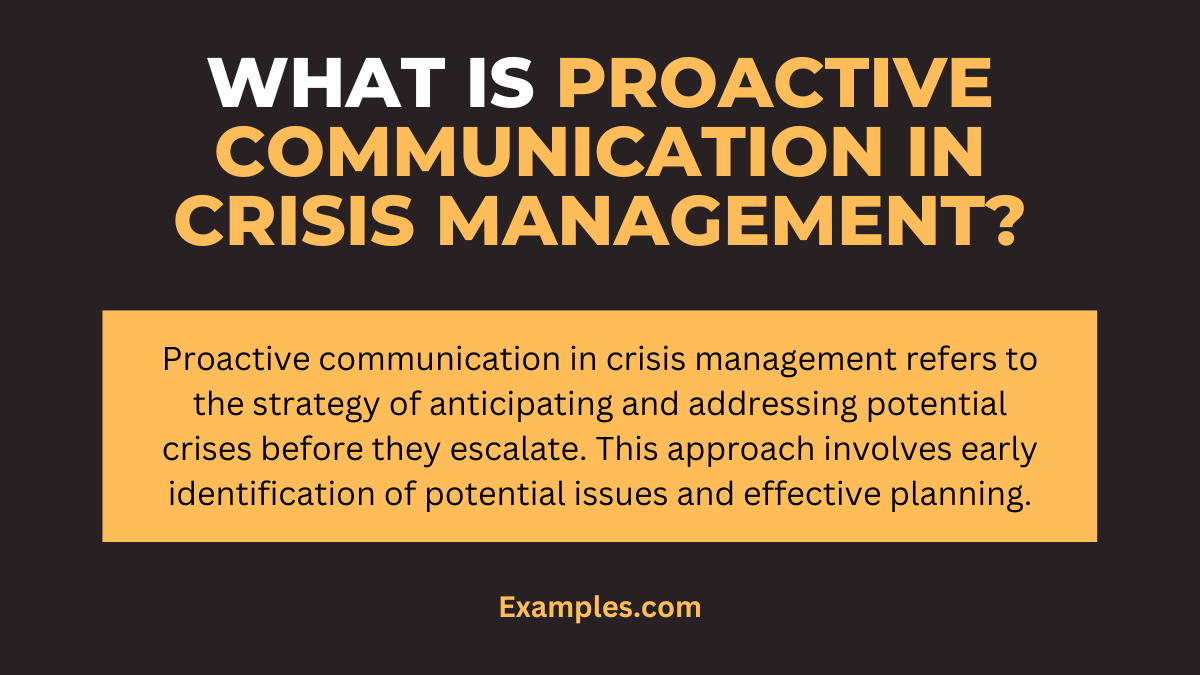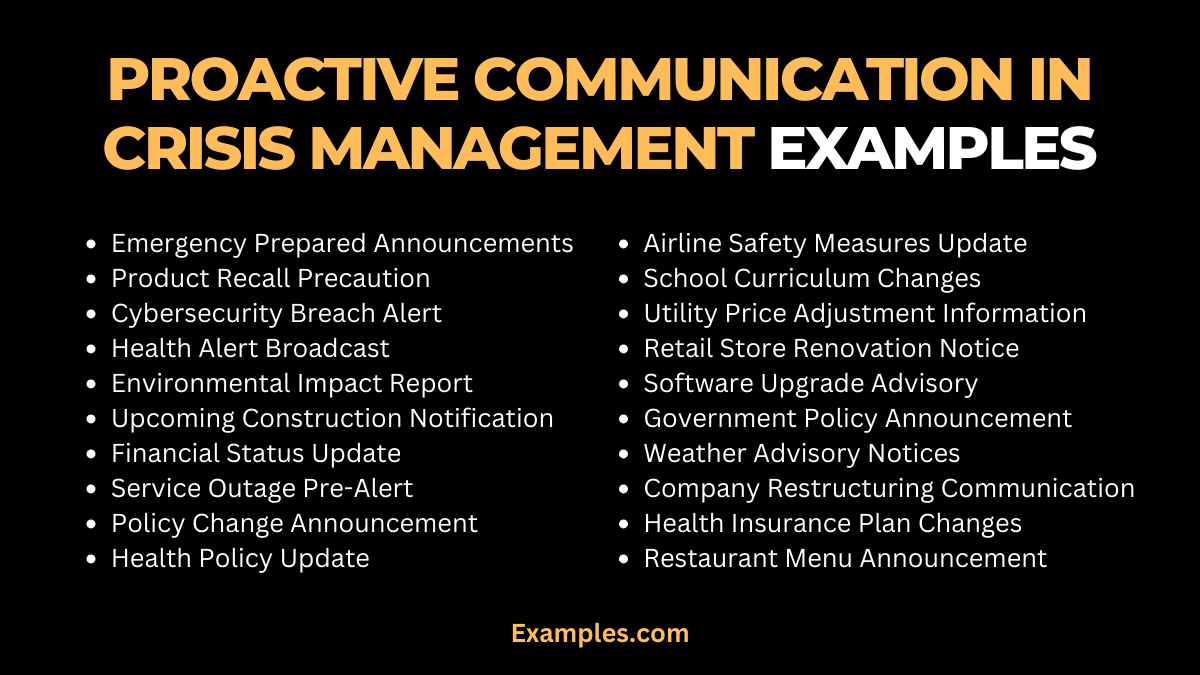19+ Proactive Communication in Crisis Management Examples
Proactive communication in crisis management is an essential strategy for organizations to effectively handle potential crises. This comprehensive guide focuses on how proactive steps can mitigate crisis impacts, with an emphasis on communication examples that illustrate these strategies in action. Covering everything from early warning systems to stakeholder engagement, the guide highlights the importance of being prepared, transparent, and responsive. Proactive communication not only helps in crisis prevention but also builds trust and maintains an organization’s reputation during challenging times.
What is Proactive Communication in Crisis Management?

Proactive communication in crisis management refers to the strategy of anticipating and addressing potential crises before they escalate. This approach involves early identification of potential issues, effective planning, and timely dissemination of information to stakeholders. By being proactive, organizations can mitigate risks, maintain control over the narrative, and build trust with their audience. It’s about staying ahead of the crisis, rather than merely reacting to it.
20 Proactive Communication in Crisis Management Examples

Proactive communication is a critical aspect of effective crisis management. It involves anticipating potential issues and addressing them before they escalate. By communicating early and openly, organizations can maintain trust, manage stakeholders’ expectations, and mitigate the impact of a crisis. This approach is centered on transparency, preparedness, and responsiveness, aiming to provide clear, accurate, and timely information. Proactive communication strategies can significantly influence an organization’s reputation and the overall outcome of a crisis situation.
- Emergency Preparedness Announcements: Prior to a natural disaster, a company sends out detailed safety guidelines and evacuation plans to all employees, ensuring everyone is informed and prepared.
- Product Recall Precaution: A toy manufacturer proactively recalls a batch of products due to a potential safety hazard before any incidents are reported, demonstrating responsibility and care for customer safety.
- Cybersecurity Breach Alert: A tech company immediately informs its users of a data breach, providing steps for protecting their information, showing transparency and a commitment to customer security.
- Health Alert Broadcast: Before the outbreak of a contagious disease, a healthcare organization disseminates preventive measures and symptoms to watch for, showcasing their concern for public health.
- Environmental Impact Report: A corporation releases a report on potential environmental impacts of their operations and the measures they are taking to mitigate them, indicating an awareness of their corporate social responsibility.
- Upcoming Construction Notification: A city council sends advance notifications about major construction projects, detailing timelines and expected disruptions, to keep residents informed and prepared for changes.
- Financial Status Update: A corporation proactively communicates about a downturn in financial performance, explaining the situation, its causes, and the steps being taken to address it, thus maintaining investor trust.
- Service Outage Pre-Alert: An internet service provider informs customers in advance about planned maintenance, thereby reducing inconvenience and frustration.
- Policy Change Announcement: Before implementing a significant policy change, a company communicates the reasons and expected benefits to employees, ensuring understanding and reducing resistance.
- Health Policy Update: A hospital communicates new visitor policies in response to a pandemic situation beforehand, ensuring that patients and visitors are aware and compliant.
- Airline Safety Measures Update: An airline proactively communicates new safety measures and protocols for post-pandemic travel, reassuring passengers about their commitment to health and safety.
- School Curriculum Changes: A school district sends out information regarding changes in curriculum or teaching methods ahead of the new school year, allowing parents and students to adapt to the new system smoothly.
- Utility Price Adjustment Information: A utility company communicates about an upcoming price adjustment due to economic factors, explaining the reasons clearly to customers to maintain transparency.
- Retail Store Renovation Notice: A retail store proactively informs customers about temporary closure for renovation, including reopening date and alternative shopping options, to manage customer expectations.
- Software Upgrade Advisory: A tech company announces an upcoming software upgrade, detailing new features and benefits, along with instructions for a smooth transition, showing their commitment to improving user experience.
- Government Policy Reforms Announcement: The government releases detailed information about upcoming policy reforms, including the rationale and expected impact, to keep the public informed and engaged.
- Weather Advisory Notices: A meteorological department proactively issues weather advisories and safety precautions in anticipation of severe weather conditions, emphasizing public safety.
- Company Restructuring Communication: A company undergoing restructuring issues an early communication to employees, outlining the reasons and future structure, to reduce uncertainty and anxiety.
- Health Insurance Plan Changes: An employer communicates changes in the health insurance plan well in advance, providing detailed information and options, to ensure employees are well-informed.
- Restaurant Menu Overhaul Announcement: A popular restaurant proactively communicates about a major menu overhaul, including the introduction of new items and removal of some old ones, to keep loyal customers informed and intrigued.
What is the Importance of Proactive Communication in Crisis Management?
Proactive communication in crisis management is crucial for several reasons. Firstly, it allows organizations to anticipate and prepare for potential issues, reducing the severity of crises. By communicating early and effectively, organizations can maintain control over the narrative, shaping public perception and response. Proactive communication also builds trust with stakeholders, as it demonstrates transparency and responsibility. Moreover, it facilitates quicker response and resolution, minimizing damage and enabling a faster return to normal operations. Proactive communication plays a critical role in crisis management by enabling organizations to anticipate and manage potential issues effectively.
What are the Proactive Communication Strategies in Crisis Management?
Proactive communication strategies in crisis management involve several key approaches:
- Early Detection: Constantly monitor for signals that could indicate a looming crisis. This involves staying informed about internal and external factors that could impact the organization.
- Pre-Crisis Planning: Develop comprehensive plans and protocols to address various potential crisis scenarios. This preparation includes identifying communication channels, key messages, and response teams.
- Effective Messaging: Create clear, concise, and informative messages in advance. Pre-crafted messages can be quickly adapted and deployed during a crisis.
- Training and Drills: Regularly train staff and conduct drills to test the crisis communication plan. This ensures that everyone knows their roles and responsibilities.
- Regular Updates: Provide consistent and frequent updates to all stakeholders during a crisis. Keeping everyone informed helps to maintain trust and manage the narrative.
- Feedback Loops: Set up mechanisms for receiving and incorporating feedback. This helps to refine and improve communication strategies continuously.
What are the Main Steps of Proactive Communication in Crisis Management?
The main steps of proactive communication in crisis management are:
- Risk Assessment: Conduct a thorough assessment to identify potential risks and vulnerabilities. Understand the types of crises that could impact your organization and the likelihood of their occurrence.
- Plan Development: Create a detailed crisis communication plan. This plan should include strategies tailored to the identified risks and be flexible enough to adapt to unforeseen events.
- Stakeholder Analysis: Identify your key stakeholders, including employees, customers, partners, and the media. Understand their needs and how they will be affected in a crisis.
- Monitoring: Set up systems to continuously monitor for signs of potential crises. This could involve social media monitoring, news tracking, or internal feedback mechanisms.
- Early Response: At the earliest sign of a crisis, promptly implement your crisis communication plan. Quick and decisive action can often prevent a situation from escalating.
- Review and Adapt: Regularly review and update your crisis communication plan. Incorporate new information, feedback from stakeholders, and lessons learned from past crises to continually improve your crisis management strategy.
How to Develop a Proactive Communication Plan in Crisis Management?
Here are instructions to Develop a Proactive Communication Plan in Crisis Management:
- Assess Potential Risks: Analyze and identify various scenarios that could pose a risk to your organization. Understanding these risks is crucial for preparing effective responses.
- Define Objectives: Clearly outline what you aim to achieve with your crisis communication. These objectives guide the overall strategy and messaging.
- Identify Key Audiences: Determine who will be impacted in a crisis and needs timely information. This includes employees, stakeholders, customers, and the media.
- Develop Key Messages: Craft messages tailored to address the concerns and questions of each audience segment. These messages should be clear, concise, and relevant to the crisis.
- Choose Communication Channels: Select the most effective channels for reaching your audiences, such as social media, press releases, or internal communication platforms.
- Establish a Crisis Communication Team: Designate a team responsible for managing crisis communication. Assign specific roles and responsibilities for efficiency.
- Train and Prepare: Regularly train your team on the plan and conduct simulations to ensure preparedness. Practice helps in refining the plan and ensures a swift response in real situations.
In conclusion, proactive communication in crisis management is vital for effective crisis handling. It involves early risk assessment, clear messaging, and strategic planning. By anticipating potential crises and establishing a robust communication framework, organizations can navigate challenges more effectively. This approach not only mitigates risks but also strengthens trust and credibility with stakeholders, ensuring resilience and stability even in turbulent times.



